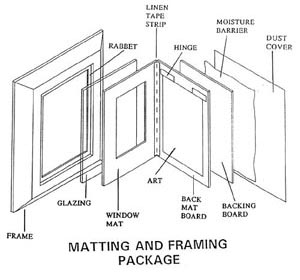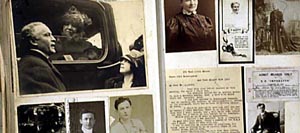[This information is taken from The
Library of Congress. For more advice, see Caring for Your Book Collection.]
To increase the life and enjoyment of your print or photograph
and to save money in the future on conservation treatments, you
should invest in appropriate preservation matting and framing.
Reviewing the following information and then interviewing the
framer regarding the procedures and materials will help you
decide.
What is preservation matting and framing?
It is the appropriate housing to display the intrinsic beauty
and interest of an object, while prolonging its life by securing
the object in a mechanically and chemically stable environment.
It minimizes the problems caused by deterioration of the
components of the object itself and other problems introduced by
environmental factors such as air pollution, heat, light, and
humidity.
What should I look for in a frame shop?
There is a growing awareness of preservation issues in the field
of matting and framing. Indiscriminate use of terms such as
"preservation quality" and "archival quality" can be misleading.
However, there are established specifications for materials, and
standards for procedures. Make sure the frame shop you select
follows them. The field of Preservation is constantly evolving.
Be an educated consumer by keeping abreast of new developments
in the preservation techniques and materials used in this field.
What materials and techniques should be used for
mats?
 A
mat is made of a series of components, as shown in this diagram.
The mat must be constructed to fit the object. Objects should
not be folded or cut to fit a mat/frame package.
A
mat is made of a series of components, as shown in this diagram.
The mat must be constructed to fit the object. Objects should
not be folded or cut to fit a mat/frame package.
The most basic guidelines are the following:
- Mat /mounting board should be made of cotton rag
or chemically purified wood pulp and must test
negative for lignin. It should be pH neutral (pH 7)
or slightly alkaline (pH 8.5). The addition of
buffering agents to unpurified wood pulp papers does
not render them fit for preservation use. Colored
board must not bleed and the color must not rub off
or fade. Board used for photographic materials must
have passed the photographic activity test (PAT).
Yellowing board suggests acid degradation and must
be replaced to prevent damage to the object.
- Board should usually be a minimum of 4-ply. Six
and 8-ply boards provide greater support and deeper
windows where needed.
- The object must be kept from contact with
glazing materials. This is particularly important
for photographs, otherwise they may adhere to the
glazing. This may be accomplished with the use of a
window mat. Sometimes the planar dimension of an
object will necessitate incorporating spacers in the
mat. If a window mat is not used, spacers must be
added along the edges of the back mat board.
- The window mat should be secured to the back mat
board with water activated linen tape adhered along
one side only. This hinge must prevent the window
mat from sliding around over the object. The object
should not come in contact with the linen tape.
- The object should be secured in a way which
accommodates some expansion and contraction. In most
instances, the object can be hinged with
long-fibered Japanese tissue adhered with wheat or
rice starch paste. There is no known
pressure-sensitive adhesive suitable for hinging an
object. Dry mount and lamination processes and glues
are damaging also. Non-adhesive attachments -- such
as acid-free paper or polyester film corners and
strips -- may be used.
What materials should be used for glazing?
- Glazing should only be glass or acrylic sheets
(e.g. Plexiglas ® , Lucite ® , Perspex® , and Lexan®
). Acrylic sheets are lighter and shatterproof, but
develop a static charge, and should not be used with
dry, unfixed pastels, charcoals, soft pencil or any
other powdery media. The static charge may displace
the powdery media.
- Sunlight and fluorescent lights emit high
amounts of ultraviolet (UV) radiation. Glass and
acrylic can both be bought with an added UV
filtering component to reduce the damaging effects
from UV. Include UV filtration in the glazing to
protect the object from UV radiation. It should be
noted that UV filtration does not eliminate the
damage caused by visible light.
- Avoid non-glare etched glass; it may have been
etched with acid which may not have been completely
neutralized.
What materials should be used for frames?
- Frames can either be wood or metal; if you
choose wood, ask that the rabbet be lined with a
barrier of some type, e.g., aluminum or polyester
tapes with acrylic adhesives. This prevents acid in
the wood from transferring to the mat package.
- Frames should be strong enough and have a deep
enough rabbet to hold the mat package securely
inside the frame.
- The mat package should be held in place with
pins or brads, never with pressure sensitive tape.
- A moisture barrier such as polyester film or
polypropylene should be placed between the back
board and the dust cover if the object will hang on
an outside wall.
What are safe places to hang or store my
framed object?
- Avoid hanging or storing anything in the
basement, attic, or any other place with extremes in
temperature and humidity. A stable, cool, dry
environment is best.
- Avoid hanging pieces on outside walls, but if
you must, request that a moisture barrier be placed
in the mat package.
- Avoid hanging objects in direct sunlight or any
other intense light source. Control exposure to
ultra violet light through glazing or placement away
from a UV source. Occasionally rotate framed objects
to cut down on the duration of light exposure.
- Avoid hanging framed objects directly above
working fire places or radiators.
The preservation procedures described here have
been used by the Library of Congress in the care of its
collections and are considered suitable by the Library
as described; however, neither the Library nor the
operators of this website will be responsible for damage
to your collection should damage result from the use of
these procedures.

 A
mat is made of a series of components, as shown in this diagram.
The mat must be constructed to fit the object. Objects should
not be folded or cut to fit a mat/frame package.
A
mat is made of a series of components, as shown in this diagram.
The mat must be constructed to fit the object. Objects should
not be folded or cut to fit a mat/frame package.